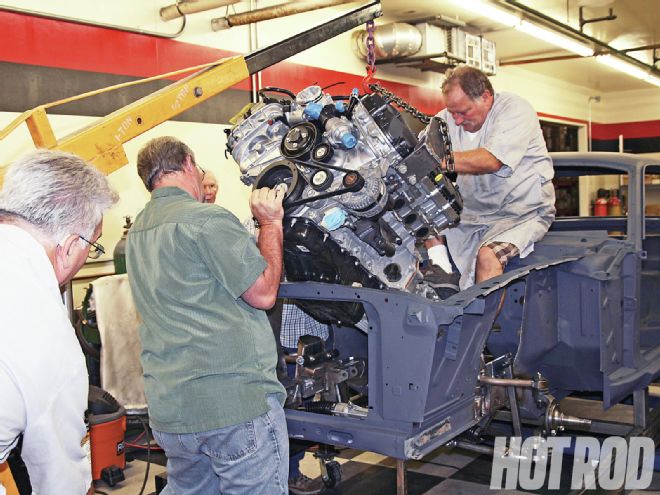
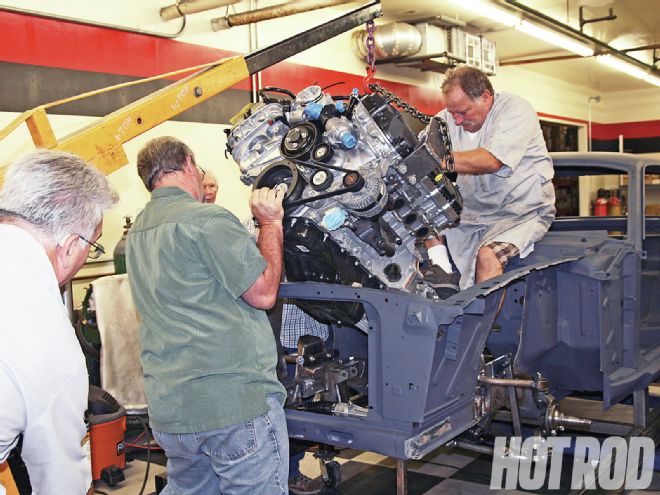 [Open wide and say “ahhh.” So you want to put a Coyote in an early Mustang? It’s doable, but be prepared for a tight squeeze, even with an aftermarket front clip like the Total Cost Involved (TCI) complete crossmember and independent front suspension that anchors Wilwood Engineering’s pioneering swap into its ’66 Mustang.
[Open wide and say “ahhh.” So you want to put a Coyote in an early Mustang? It’s doable, but be prepared for a tight squeeze, even with an aftermarket front clip like the Total Cost Involved (TCI) complete crossmember and independent front suspension that anchors Wilwood Engineering’s pioneering swap into its ’66 Mustang.
Thanks to quick support from Ford Racing Performance Parts (FRPP), the Mustang's high-tech DOHC '11-and-later 5.0L TI-VCT Coyote engine is hitting critical mass among Blue Oval engine-swap enthusiasts. Last month, we covered the basics of retrofitting those engines into earlier hot rods and muscle cars. Now, it's time to turn theory into reality, as we delve into the innards of real-world Coyote swaps in a variety of late and early chassis. If there's a common thread among these swaps, it's this: The Coyote is wide; front accessory drives are critical (often mandating an aftermarket or even a custom solution, especially if you want to run hydraulic power steering and air conditioning); clearance for an old-school power-brake vacuum booster is nil, and in older chassis (especially those with high shock towers), it's wise to axe the old, obsolete front end for an aftermarket front clip with rack-and-pinion steering. On the plus side, as detailed last month, FRPP's Control Pack (PN M-6017-A504V) makes things a lot easier in the electronics and wiring department—at least with a stick shift. Read on to find out how pioneers are successfully crossbreeding the Coyote.
Wilwood Engineering is dropping—or maybe we should say cramming—a Coyote into its '66 Mustang. Arguably, the '641⁄2–'66 'Stangs and their early Falcon sisters provide the ultimate test of Coyote fitment and engineuity: They have the narrowest engine bays, plus intrusive, high-mount shock towers. Frankly, the engine swap is well-nigh impossible without an aftermarket front clip that axes the shock towers in favor of a modern rack-and-pinion steering and suspension setup. That's where TCI rides to the rescue with its complete front end. Helping ease fitment are Doug's brand-new, long-tube headers that are designed specifically to fit the TCI clip. Out back, you'll see TCI's trick torque-arm rear suspension supporting a full-floating Strange Engineering 9-inch rearend.
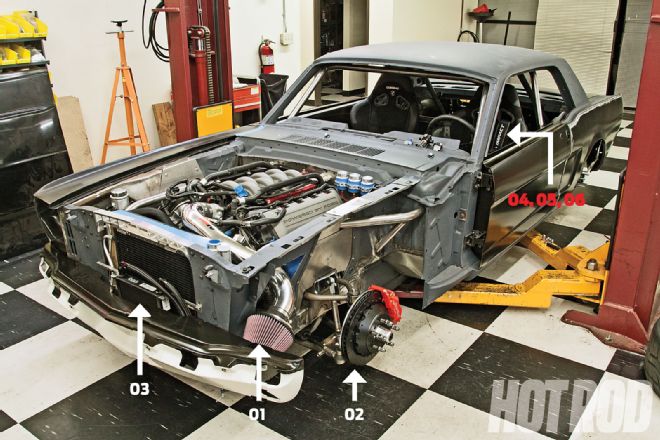 Wilwood's '66 Mustang will showcase its brake products on the Pro Touring circuit and serve as a road-course development mule, so it's set up for serious handling and braking. It's the first swap we've seen that doesn't use a FRPP crate engine; instead, it's a completely stock, low-mileage, '11 Mustang GT 5.0L takeout, along with its six-speed manual trans, clutch, and hydraulic release bearing. 01 Intake Duct. 02 Wilwood Superlite Brakes. 03 Radiator and Cooling. 04, 05, 06 interior, Trans Tunnel, Pedals.
Wilwood's '66 Mustang will showcase its brake products on the Pro Touring circuit and serve as a road-course development mule, so it's set up for serious handling and braking. It's the first swap we've seen that doesn't use a FRPP crate engine; instead, it's a completely stock, low-mileage, '11 Mustang GT 5.0L takeout, along with its six-speed manual trans, clutch, and hydraulic release bearing. 01 Intake Duct. 02 Wilwood Superlite Brakes. 03 Radiator and Cooling. 04, 05, 06 interior, Trans Tunnel, Pedals.
This swap uses a wrecking-yard takeout Coyote engine and trans. Wilwood intended to include the stock production Powertrain Control Module (PCM, aka "the computer"), but at present, the stock antitheft system can't be bypassed. When we shot these photos, FRPP's Control Pack (which includes the PCM) had just arrived but had not yet replaced the production unit dummied in place. Using the FRPP solution requires going from a production-style, returnless fuel system to a return-style fuel system. The car will have a Rick's Stainless custom gas tank with a VaporWorkz EFI pump system and Aeromotive regulator, fuel lines, and fuel rails. "It's the only way to go," proclaims Wilwood's Dustin Burr.
If you look closely, the car has all sorts of custom touches, including a smooth sheetmetal firewall and a billet-aluminum radiator core support. The firewall's location is stock, but Burry says, "Given all the firewall and trans-tunnel mods we had to do anyway, if we had to do it all over, we'd set the engine back another foot for better weight balance." The support, fabbed by Wilwood on its in-house CNC equipment, is not strictly necessary for engine fitment but does make for easier (and faster) engine/trans removal and installation.
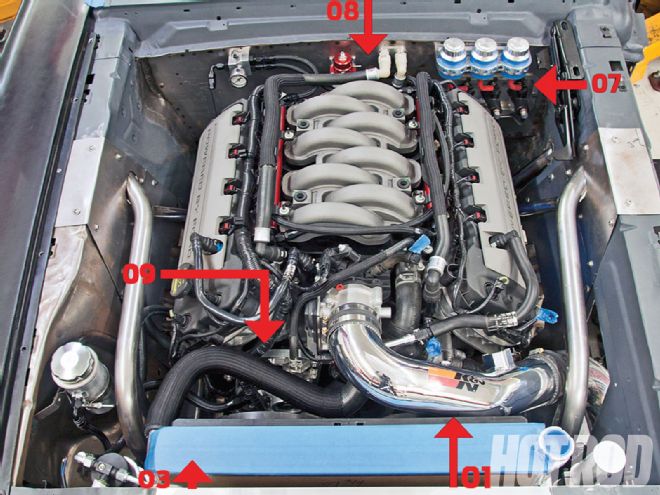 01 Intake Duct
03 Radiator and Cooling
07 Willwood Triple-Mount Cylinders
08 Heater hose fittings, Fuel Pressure Regulator
09 A/C, P/S
01 Intake Duct
03 Radiator and Cooling
07 Willwood Triple-Mount Cylinders
08 Heater hose fittings, Fuel Pressure Regulator
09 A/C, P/S
C&R Radiators builds this aluminum radiator for a ’66 Mustang with a Coyote engine. “It came with the electric fans already mounted and fit like a glove,” Burr says. Factory ’11 Mustang GT radiator hoses fit if the bottom hose’s vertical portion is sectioned about 2½ inches. A Setrab engine-oil cooler mounts in front. Dig the Wilwood-fabbed, billet-aluminum core support.
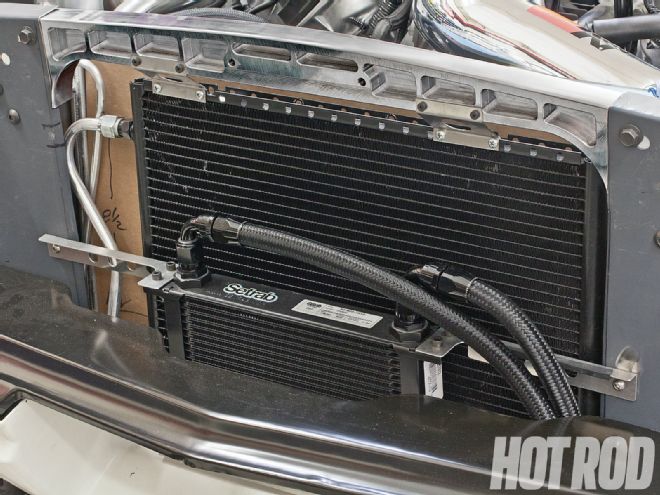
Wilwood’s R&D shop made billet bulkhead connectors that accept the stock Ford heater hoses and their quick-disconnect clips. Behind them is the Aeromotive fuel-pressure regulator needed for return-style fuel injection.
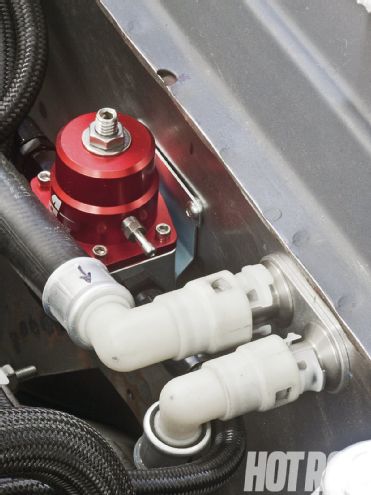
Old Mustang steering columns extend far into the engine bay; they’d have to be considerably shortened to work with a modern front end. Instead, Wilwood is going with an ididit custom job. Either way, a Borgeson Double-D steering shaft is typically used to join column to rack. Its spline end connects to the column, the U-jointed end to the rack.
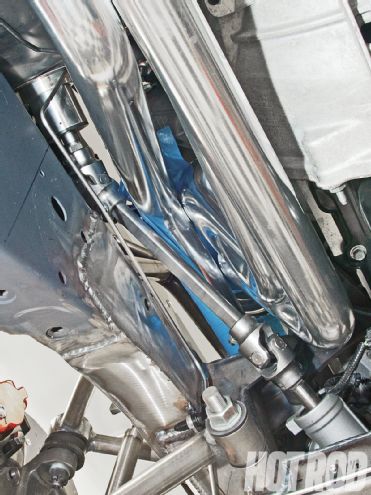
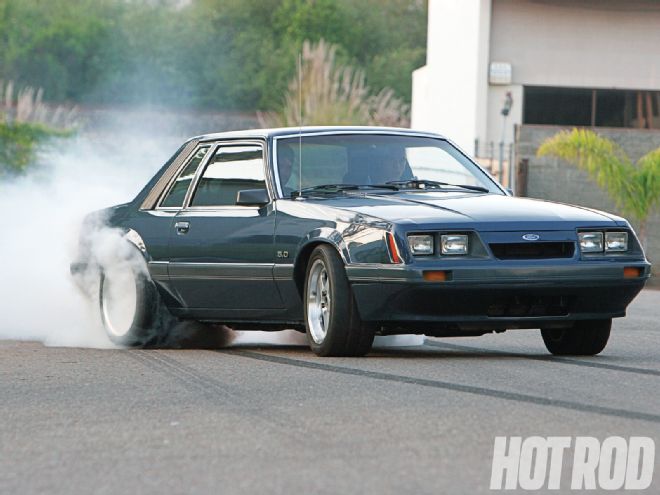 Christian France road-races his ’86 Mustang on Sunday and drives it to work on Monday. His Ford Racing TI-VCT crate engine (PN M-6007-M50) is backed by a T56 six-speed and beefed-up 8.8-inch Ford rearend. Maximum Motorsports supplied most of the hard-core underpinnings, including the bolt-in Fox-body front K-member set up for Ford Modular motor mounts. The numbers refer to the detail photos on these pages.
Christian France road-races his ’86 Mustang on Sunday and drives it to work on Monday. His Ford Racing TI-VCT crate engine (PN M-6007-M50) is backed by a T56 six-speed and beefed-up 8.8-inch Ford rearend. Maximum Motorsports supplied most of the hard-core underpinnings, including the bolt-in Fox-body front K-member set up for Ford Modular motor mounts. The numbers refer to the detail photos on these pages.
Coyote Mates With Fox-Body
Christian France has owned his '86 Mustang notchback for years. Over that time, it's seen various drivetrain combos, serving as a showcase for his business—High Flow Performance (HFP)—as well as being a fun car equally at home on the street, at the slaloms, or on the track. In its latest incarnation, it's propelled by a Ford Racing TI-VCT 5.0L Coyote, normally aspirated crate engine, with gear changes handled by an '03–'04 Cobra T56 six-speed upgraded with a 26-spline input shaft that bolts to the motor via a Cobra bellhousing. France says any '96–'04 eight-bolt crank-flange flywheel and cable-clutch configuration with a single- or dual-disc that has the right spline count to match the input shaft works. No trans tunnel or shifter-hole mods are needed.
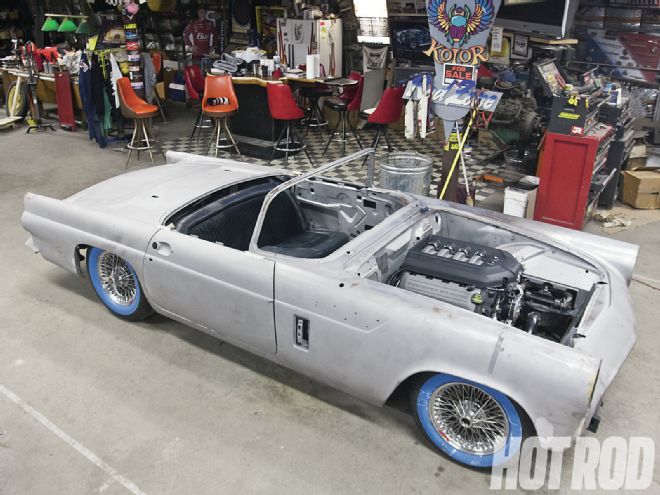 01 Engine-Frame Clearance 02] PCM (Computer) 03] Custom Inlet Duct 04] Radiator and Fans 05] Engine Coolant Surge Tank 06] Hydroboost Master Cylinder
01 Engine-Frame Clearance 02] PCM (Computer) 03] Custom Inlet Duct 04] Radiator and Fans 05] Engine Coolant Surge Tank 06] Hydroboost Master Cylinder
France set the engine in place using a Maximum Motorsports K-member (PN MMKM-2.1). In fact, the chassis' underpinnings are virtually all by Maximum. Explains France, "This is an open-track car, so the entire suspension was upgraded with Maximum Motorsports components, front to rear, to handle the Coyote motor's power and bring its handling up to modern standards. The 8.8 rearend was completely rebuilt using an Eaton posi, 31-spline forged axles, straightened and welded axlehousing tubes, new bearings, and a rear girdle."
The return-style fuel system retains a standard 5.0L fuel tank but uses a proprietary in-tank HFP pump that's capable of supporting 550 hp. It and many of the components referenced in the photos are available through HFP.
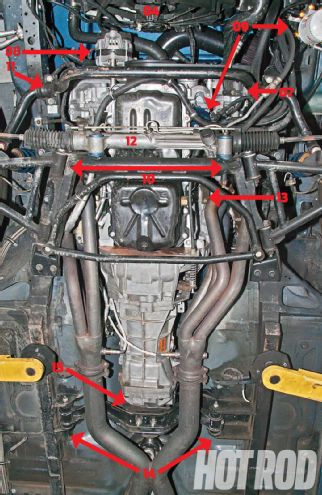 04] Radiator and Fans 07] Power Steering Pump 08] Relocated Alternator 09] Remote Oil Filter 10] Maximum Motorsports K-Member 11] Antisway Bar Mount 12] R&P Steering Clearance 13] Engine Mounts, Steering Coupler 14] Trans Crossmember 15] Trans Mount]
04] Radiator and Fans 07] Power Steering Pump 08] Relocated Alternator 09] Remote Oil Filter 10] Maximum Motorsports K-Member 11] Antisway Bar Mount 12] R&P Steering Clearance 13] Engine Mounts, Steering Coupler 14] Trans Crossmember 15] Trans Mount]
Overall, France proclaims he's "100 percent satisfied. It starts up like a new car. Yes, it drives like an older car with stiff and upgraded handling components, but that's one of the realities of using an older chassis as the swap platform. The newer the car, the more refined the swap experience—but also the heavier the car. This car weighs 3,260 pounds wet with a half tank of fuel and a 180-pound driver."

Seen at Hot Rods by Dion (Mt. Clemens, Michigan), Dave Foshe's vintage 1956 Ford Thunderbird is getting a complete makeover, courtesy of a FRPP 5.0L Coyote crate engine (PN M-6007-M50) and a bunch of FRPP accessories. Fitting the engine into the old chassis was relatively straightforward, reports Foshe: "The only major problem was the front-drive for the A/C and P/S. It had to be very compact to fit behind the front crossmember that we relocated forward. Other than that, only minor frame notching was needed."
The trans is a Performance Automatic–built 4R70W four-speed automotic overdrive from an earlier 4.6L engine with a six-bolt crank flange. Late Model Restoration's eight-bolt flexplate bolts its torque converter to the Coyote's crank flange. A spacer fits between the trans and engine to clear the Coyote's tone ring while also better supporting the starter. Custom linkage was made to allow retention of the original T-bird shifter. FRPP's stand-alone PCM won't control an automatic, so Performance Automatic's stand-alone controller will be used. At least the 4R70W can still drive a mechanical speedo.
The Coyote is much shorter than the T-bird's original 312 V8, so radiator and electric-fan clearance isn't a problem. Foshe will get a custom gas tank that will clear the bulkier Ford 9-inch rearend (the original was a Dana 44) and be fully set up for a return-style EFI system.
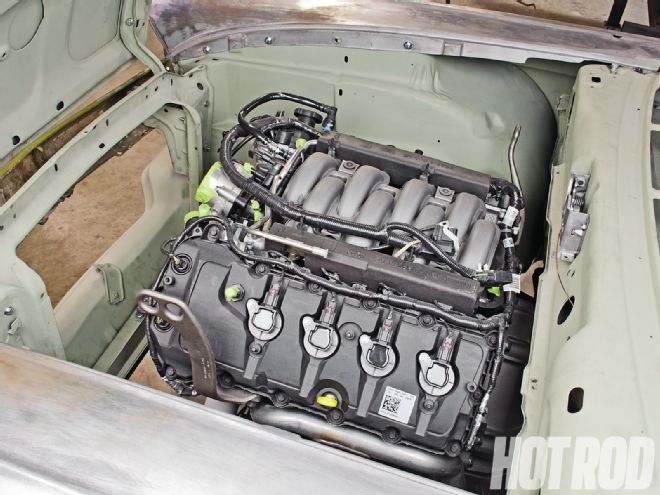 Where a FE big-block once resided, FRPP’s ubiquitous M-6007-M50 crate engine now seems right at home. “We looked at the 390 in there and thought swapping the Coyote would be easy, but it’s wider by a long shot,” remarks owner Rick Smith. No firewall mods were needed. However, there’s no room for a brake vacuum booster, so a ’96–’04 Mustang V8 hydroboost will be used.
Where a FE big-block once resided, FRPP’s ubiquitous M-6007-M50 crate engine now seems right at home. “We looked at the 390 in there and thought swapping the Coyote would be easy, but it’s wider by a long shot,” remarks owner Rick Smith. No firewall mods were needed. However, there’s no room for a brake vacuum booster, so a ’96–’04 Mustang V8 hydroboost will be used.
When we found Rick Smith's 1957 Ford Fairlane 500 at Reiter's Metal Craft (Mt. Clemens, Michigan), it still had a ways to go, but the long-term plan is for a bulletproof daily driver using as many FRPP and OE-quality parts as possible. The 5.0L TI-VCT crate engine is managed by FRPP's Control Pack. Behind it is a Tremec heavy-duty five-speed and a 3.73-geared 9-inch Ford rearend supported by Chrysler Super Stock leaf springs. "These springs flat work, they ride nice, they won't raise the car," Smith comments. Future plans call for adapting an entire '11 Mustang cooling and A/C module out of a wrecking yard, including the condenser, radiator, engine-oil cooler, and electric fan module. "Grab everything from the front of the car, all bolted together; everything comes out in one shot." A custom tank will be fabricated that's properly baffled for an-tank FRPP '11 Mustang fuel pump.